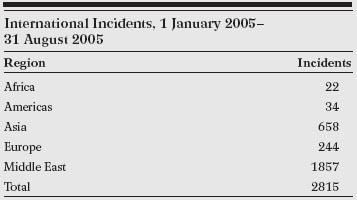Overview of Incidents
出处:按学科分类—政治、法律 BERKSHIREPUBLISHINGGROUP《PatternsofGlobalTerrorism1985-2005:U.S.DepartmentofStateReportswithSupplementaryDocumentsandStatistics》第974页(3925字)
Anna Sabasteanski
This set of graphs includes the following illustrations, based on the numbers of attacks that the Department of State has designated as significant:
■ international incidents by region (1981-2004)
■ anti-U.S. attacks compared to attacks (1981-2004) in total
■ anti-U.S. attacks compared to attacks (1981-2004) as relative percentages
■ anti-U.S. attacks by region (1985, 1990-2004).
As demonstrated in these graphs, in the past two decades, terrorism spread from Europe through the Middle East and increased around the globe.The number of incidents has increased in every region, including large numbers in the Middle East and recent sharp spikes in Asia.
These numbers have grown even more rapidly in 2005. Determination of which attacks are considered “significant” has not been concluded, but comparing the total number of international attacks is instructive. In 2004, there were a total of 2,571 attacks, of which 651 were deemed “significant” and included in the NCTC report that supplemented the Department of State’s Country Reports on Terrorism. The first eight months of 2005 has already significantly exceeded last year’s record total.
The overall percentage of attacks directed against U.S. interests remains a relatively small part of the whole, although it too is increasing.
Anti-U.S. data was taken from annual Patterns of Global Terrorism. Specific detail is not available for all years. Please note that 1968-1997 data covers only international incidents while 1998-present includes domestic incidents as well.
The general trends are discussed in the annual regional overviews and country reports.
The international data is retrieved from the National Counterterrorism Center’s (NCTC) Worldwide Incidents Tracking System (WITS) and the MIPT Terrorism Knowledge Base that integrates data from the RAND Terrorism Chronology and RAND-MIPT Terrorism Incident databases.

Table developed in part from data retrieved from the MIPT errorism Knowledge Base in September 2005.
We have grouped this data into five standard regions: Africa, Americas, Asia, Europe, and Middle East. In both Patterns and in WITS, regional designations may vary. For example, Egypt is variously considered Middle East and North Africa. We did not normalize this data. Americas includes North America, Central America, South America, and the Caribbean. Europe used to be divided between East and West. For this analysis, Eastern Europe and the Soviet Union joined Western Europe. The independent states east of the Caucasus that were created after the collapse of the Soviet Union (Central Asia) are included in Asia, while the Caucasus states and those to the west, including the Russian Federation, are included in Europe. In addition to Central Asia, South Asia, East Asia, Southeast Asia, and Oceania are incorporated in the general regional category of Asia.
NCTC’s methodology is explained in full on its website (http://www.tkb.org/NCTCMethodology.jsp). In the database, it includes “incidents in which subnational or clandestine groups or individuals deliberately or recklessly attacked civilians or noncombatants.” To be included, the attack must have been initiated and executed. Failed or foiled attacks, hoaxes, and spontaneous hate crimes without intent to cause mass casualties are excluded “to the greatest extent practicable.” Genocide is excluded, “in part because of the inherent difficulty in counting such events and because the inevitable undercount does not do justice to the scope and depth of such atrocities.”